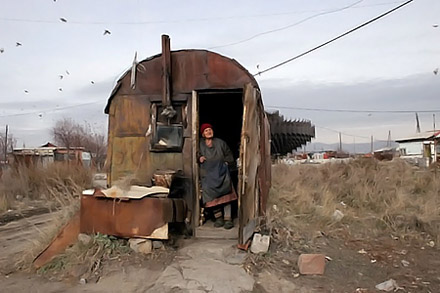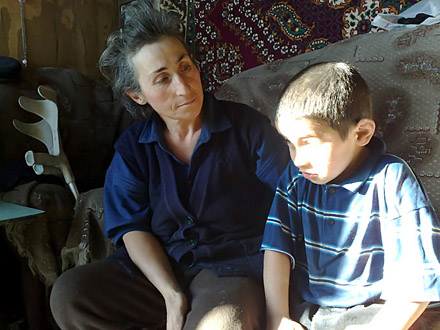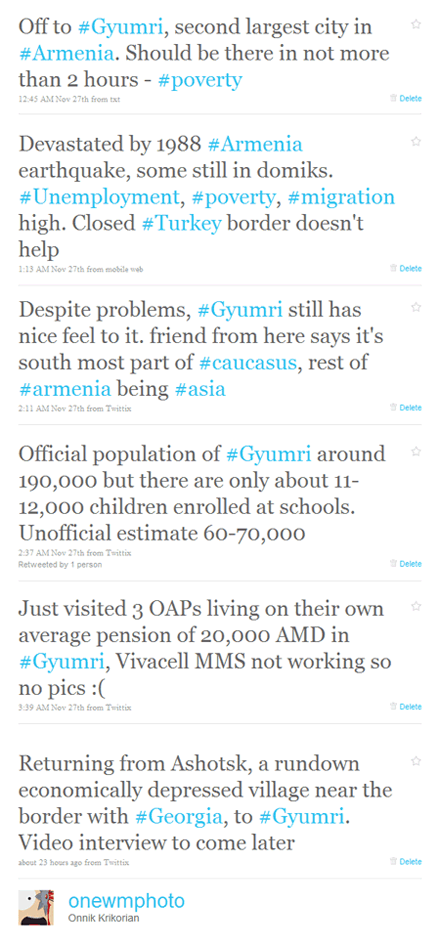
Still living in temporary shelter 21 years after the earthquake, Gyumri, Shirak Region, Republic of Armenia © Onnik Krikorian / Oneworld Multimedia
Monday marked the 21st anniversary of the 1988 earthquake which devastated many areas in northern Armenia leaving around 25,000 dead and many more homeless. Yet, despite a huge inflow of money from international donors for reconstruction, conditions still remain harsh more than two decades on with thousands still living in domiks — temporary accommodation such as simple shacks or even metal containers.
Precise numbers for the number of families in Armenia's second largest city of Gyumri still living in such a situation are still unknown, but it is believed to be around 4-7,000. But while the government has promised to provide them with apartments by the end of the year, bloggers continue to focus on the problems faced by many. Peaches and Pomegranates visited Gyumri a day before the anniversary.
It was a fitting time to be in the city as Monday will be a remembrance day for those who lost their lives during the devastating earthquake. Gyumri also lies close to the Turkish border. […]
[…]
I fell in love with the small city. Despite the sadness sown by the earthquake, a subtle beauty exists in the crumbling 19th century buildings. […]
Writing on the Birthright Armenia blog, one ethnic Armenian volunteer from the Diaspora recounts his time in the city working with a journalist organization as well as the local Caritas Armenia NGO, and one encounter in particular.
I can tell you that if you dig, you will find out what a “domik” is, what it looks like, what it smells like, which legally blind man lives alone in a particular one in the “Barracks” district; you will find out that besides the legally blind man, 7,500 families still live in domiks; you will understand the true nature of hospitality; you will realize where the mistrust of government stems from; […] you will know why your host grandfather’s eyes glaze over whenever he talks about anything circa 1988; […] you will uncover that nearly all marshrutka’s are privately owned by the mayor and drivers pay 2,000 AMD a day to rent them; you will realize that the youth are bored and disenchanted; […] you will realize why people want to leave…and why they want to stay.
Of course, digging around in Gyumri requires sifting through a lot of rubble. In most cases it’s psychological rubble. I met my host uncle Moso the very first night I was there. […] Oh, and he was deaf… which was an interesting surprise for my first night there […]. He taught me Armenian sign language (I don’t know if he was kidding or not, but the sign for “Gyumri” is apparently to beat your chest with your fists…like a silverback gorilla, while the sign for Yerevan kind of looks like playing the world’s tiniest violin). […] He could read lips and he could even sound a few words, having lost his hearing when he was three years old. That is…21 years ago. That is…in 1988. […] I forget how I brought it up, but he started telling me about his experience in the earthquake. Apparently, he was standing outside his school when buildings began collapsing. His father had rushed over to him and snatched him up, just as his own school began crumbling in front of his eyes. He didn’t hear after that.
Another foreign visitor to Gyumri for the anniversary was Ashley Corinne Killough, a Fullbright scholar in Armenia. She posts an account and an audio slideshow (above) of another encounter made through Caritas Armenia on her blog.
More than two decades after the 1988 earthquake that killed one out of every 12 people and left hundreds of thousands homeless in Gyumri, Armenia, the city is still recovering. Unemployment numbers are dire, and many dilapidated, unusable buildings remain standing.
An estimated 4,000-5,000 families still live without proper homes. They wait for housing while living in the same “domiks,” or Soviet cargo containers, that they inhabited 20 years ago. There are others who have apartments, but the conditions are barely livable.

Cartias Armenia beneficiaries living in temporary shelter, Gyumri, Shirak Region, Republic of Armenia © Onnik Krikorian / Oneworld Multimedia
A little over a week earlier, other photos and tweets from visiting beneficiaries with Caritas Armenia were posted on my Frontline Club blog. There was also a video interview with the local NGO's media and press person.

For readers living in Armenia, photographer Anush Babajanyan has an exhibition of her multi-year photographic project documenting families in Gyumri underway in Yerevan until 6 January 2010. Some of her work can also be viewed on her personal blog as well as Transition Online's Patchwork.







5 comments